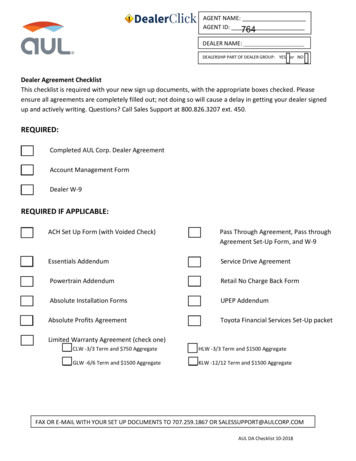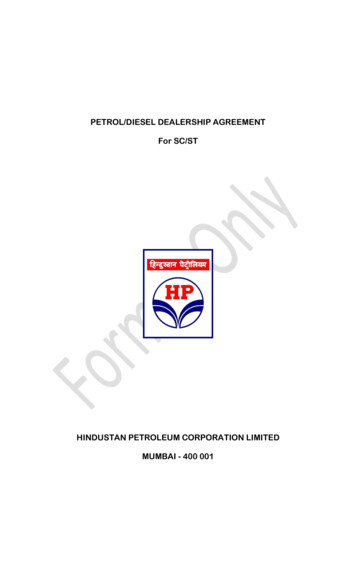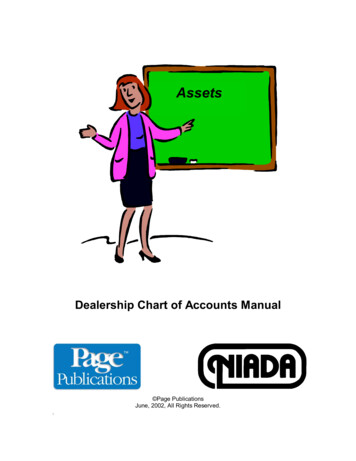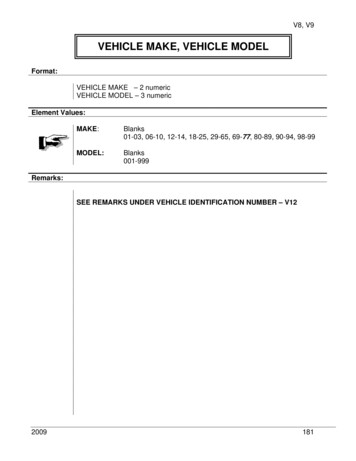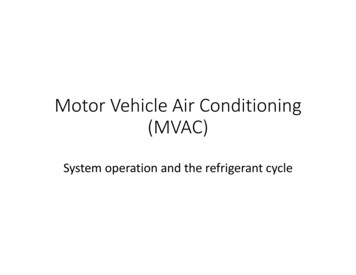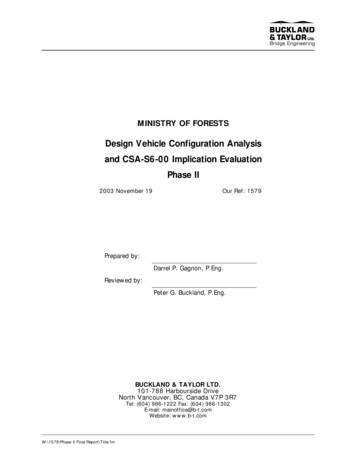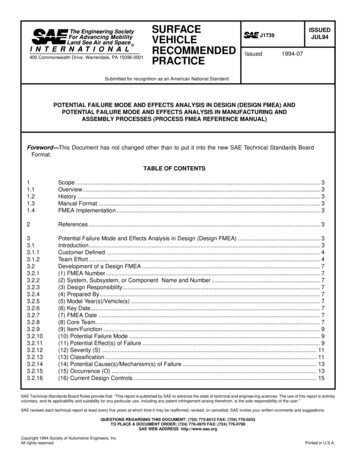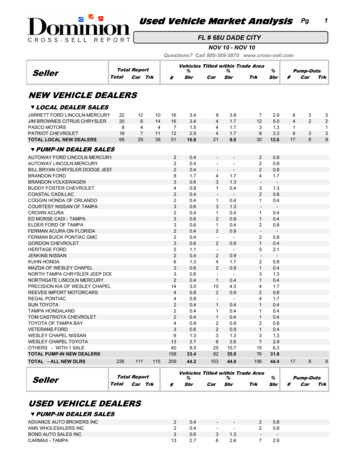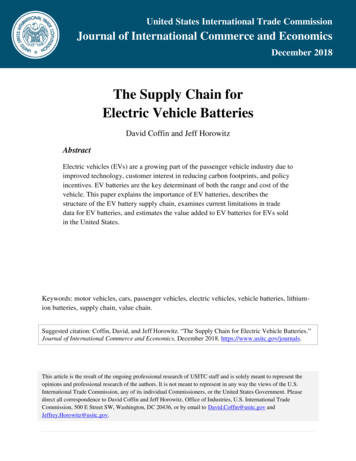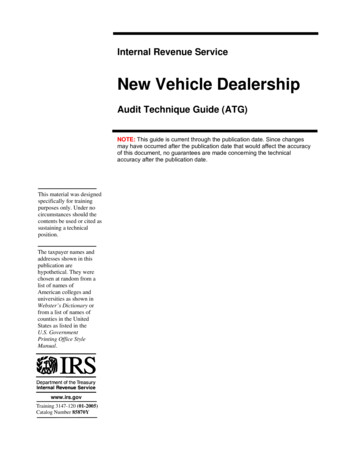
Transcription
Internal Revenue ServiceNew Vehicle DealershipAudit Technique Guide (ATG)NOTE: This guide is current through the publication date. Since changesmay have occurred after the publication date that would affect the accuracyof this document, no guarantees are made concerning the technicalaccuracy after the publication date.This material was designedspecifically for trainingpurposes only. Under nocircumstances should thecontents be used or cited assustaining a technicalposition.The taxpayer names andaddresses shown in thispublication arehypothetical. They werechosen at random from alist of names ofAmerican colleges anduniversities as shown inWebster’s Dictionary orfrom a list of names ofcounties in the UnitedStates as listed in theU.S. GovernmentPrinting Office StyleManual.www.irs.govTraining 3147-120 (01-2005)Catalog Number 85870Y
New Automobile DealershipTable of ContentsChapter 1 General Focus, Procedures and getting setting startingIntroduction . . . . . . . . . . . . . . . . . . . . . . . . . . . . . . . . . . . . . . . .Getting Started . . . . . . . . . . . . . . . . . . . . . . . . . . . . . . . . . . . . .1-11-1Chapter 2 Books and RecordsCharacteristics . . . . . . . . . . . . . . . . . . . . . . . . . . . . . . . . . . . . .Books and Records General Ledger Audit Example . . . . . . . .Conclusion . . . . . . . . . . . . . . . . . . . . . . . . . . . . . . . . . . . . . . . .2-12-32-6Chapter 3 Balance SheetIntroduction . . . . . . . . . . . . . . . . . . . . . . . . . . . . . . . . . . . . . . . .Conclusion . . . . . . . . . . . . . . . . . . . . . . . . . . . . . . . . . . . . . . . .3-13 -22Chapter 4 InventoryIntroduction . . . . . . . . . . . . . . . . . . . . . . . . . . . . . . . . . . . . . . . .A short history of LIFO application. . . . . . . . . . . . . . . . . . . . . . .4-14-4Chapter 5 LIFOIntroduction . . . . . . . . . . . . . . . . . . . . . . . . . . . . . . . . . . . . . . . .LIFO Concepts . . . . . . . . . . . . . . . . . . . . . . . . . . . . . . . . . . . . . . . .Pooling . . . . . . . . . . . . . . . . . . . . . . . . . . . . . . . . . . . . . . . . .LIFO Election . . . . . . . . . . . . . . . . . . . . . . . . . . . . . . . . . . . . . . . .LIFO Computations . . . . . . . . . . . . . . . . . . . . . . . . . . . . . . . . . . . . . .5-15-15 -115 -165 -21Chapter 6 Alternative LIFO for Auto DealersIntroduction . . . . . . . . . . . . . . . . . . . . . . . . . . . . . . . . . . . . . . . .LIFO Pooling . . . . . . . . . . . . . . . . . . . . . . . . . . . . . . . . . . . . .Used Vehicle Alternative LIFO Method 6-16-16-9Chapter 7 Extended Service Contracts and Aftermarket ProductsIntroduction . . . . . . . . . . . . . . . . . . . . . . . . . . . . . . . . . . . . . . . .Extended Service Contracts . . . . . . . . . . . . . . . . . . . . . . . . . . .Credit Life Insurance; Credit Accident and Health Insurance . .General ESC . . . . . . . . . . . . . . . . . . . . . . . . . . . . . . . . . . . . . . . .Agent versus Principal/Obligor . . . . . . . . . . . . . . . . . . . . . . . . . .Service Warranty Income Method (SWIM) . . . . . . . . . . . . . . . . .VSC Audit Technique Flow Chart . . . . . . . . . . . . . . . . . . . . . . . .7-17-17-27-37-47-97 - 19Chapter 8 PORCIntroduction . . . . . . . . . . . . . . . . . . . . . . . . . . . . . . . . . . . . . . . .General Structure Example . . . . . . . . . . . . . . . . . . . . . . . . . . . .Applicable Code Sections . . . . . . . . . . . . . . . . . . . . . . . . . . . . . .8-18-58-6
Chapter 9 Advertising AssociationsIntroduction . . . . . . . . . . . . . . . . . . . . . . . . . . . . . . . . . . . . . . . . .Supporting Law . . . . . . . . . . . . . . . . . . . . . . . . . . . . . . . . . . . . . .9-19-4Chapter 10 Sales of DealershipsIntroduction . . . . . . . . . . . . . . . . . . . . . . . . . . . . . . . . . . . . . . . . .Supporting Law . . . . . . . . . . . . . . . . . . . . . . . . . . . . . . . . . . . . . .10 - 110 - 5Chapter 11 Related Finance CompaniesIntroduction . . . . . . . . . . . . . . . . . . . . . . . . . . . . . . . . . . . . . . . . .How does it work? . . . . . . . . . . . . . . . . . . . . . . . . . . . . . . . . . . . .Issue Identification . . . . . . . . . . . . . . . . . . . . . . . . . . . . . . . . . . . .Initial Document requests. . . . . . . . . . . . . . . . . . . . . . . . . . . . . .Supporting Law . . . . . . . . . . . . . . . . . . . . . . . . . . . . . . . . . . . . . .11 - 111 - 111 - 311 - 1111 - 13Chapter 12 Passive / Non-Passive ConsiderationsIntroduction . . . . . . . . . . . . . . . . . . . . . . . . . . . . . . . . . . . . . . . . .Should this issue be considered? . . . . . . . . . . . . . . . . . . . . . . . .Conclusion . . . . . . . . . . . . . . . . . . . . . . . . . . . . . . . . . . . . . . . . .12 - 112 - 112 - 2Chapter 13 Voluntary Employees' Benefit AssociationsWhat is a VEBA . . . . . . .Issue Identification . . . . . . . . . . . . . . . . . . . . . . . . . . . . . . . . . . . .13 - 113 - 3Chapter 14 Other Auto Dealership IssuesIntroduction . . . . . . . . . . . . . . . . . . . . . . . . . . . . . . . . . . . . . . . . .Service Technician Tool Reimbursements . . . . . . . . . . . . . . . . . .Manufacturer’s Incentive Payments to Vehicle Salespersons. . . .Shuttling Services & Drivers/shuttlers. . . . . . . . . . . . . . . . . . . . . .Holdback charges. . . . . . . . . . . . . . . . . . . . . . . . . . . . . . . . . . . . . .Warranty advances . . . . . . . . . . . . . . . . . . .Finance Reserves . . . . . . . . . . . . . . . . . . . . . .Compensation Issues. . . . . . . . . . . . . . . . . . . . . . . . . . . . . . . . . . . .Other Issues . . . . . . . . . . . . . . . . . . . . . . . . . . . . . . . . . . . .Glossary . . . . . . . . . . . . . . . . . . . . . . . . . . . . . . . . . . . Sources of Information . . . . . . . . . . . . . . . . . . . . . . . . . . . . . . . . . . .14 - 114 - 114 - 614 - 714 – 814 - 1014 - 1114 – 1214 – 2314 – 3014 – 31
Chapter 1General Focus, Procedure and Getting StartedINTRODUCTIONIn preplanning an examination of an automobile dealership, a review of the return, as iscustomary, could pose interesting questions to begin the audit. An agent knows thereare a variety of internal research tools with which to start. By securing information fromthe Integrated Data Retrieval System (IDRS), an agent may be able to perform apreliminary comparative analysis of the income and deduction items as well as thebalance sheet which would provide initial information useful to the agent.Many dealerships have begun conducting business transactions utilizing e-commerce,or the Internet. Using a search engine to look at a dealership’s website may providesome background information on a specific dealership.The return may be a consolidation of two or more entities created for the benefit of theautomobile dealer. The separate entities provide the dealership the ability to clarifyoperations and distinguish activities. If the return is a large consolidated operation, flowthrough schedules or other accompanying statements are disclosed on the returnidentifying these activities.New automobile dealerships maintain good internal controls and prepare completebooks and records. Dealerships as franchisees, properly book sales activities toconform to the financial statement requirements imposed in the form of themanufacturers statements by the franchiser, the factory. Once the income is booked,some dealerships may incorrectly treat or classify them for tax purposes. This mayoccur through shifting of business activities to related entities.An entity chart is helpful in visualizing the organizational structure. It is important that allrelated returns are gathered. One entity may own the land where the dealershipoperations are and rent is paid to the shareholder. Another entity may be an insurancecompany formed to facilitate the paper flow of extended service contract sales or amanagement company is formed to receive management fees. All three are relatedentities and related party transactions should be examined. An understanding of eachentity’s activities, business purpose and tax implications would be required.GETTING STARTEDThe key to a quick and competent closure of any new vehicle dealership examinationhinges on narrowing the scope of the examination to items that may prove productive.This section addresses tools necessary to frame the scope of the examination and totransition from planning to the start of the examination of the books and records.Chapter 1, General Focus, Procedure and Getting Started1
In order to determine the examination’s focus, request copies of the following before theinitial interview. These documents form the cornerstone of any auto dealershipexamination:Pre-Interview Documents to request:1. Unadjusted Trial Balance and Adjusting Journal Entries2. Tax Classification Work Papers3. Manufacturer's StatementAudit Techniques:1. An agent obtaining this information before the initial appointment will be able toaccomplish two objectives.a. First, the agent will be able to reconcile the trial balance to the tax return.b. Second, the agent will be able to ask more pointed questions during theinitial interview.ReconciliationRegarding the reconciliation, it is recommended the agent do a full reconciliation of thetrial balance and the adjusting journal entries to the tax return. By doing a little work upfront the agent should have a specific understanding of the underlying transactions thatmake up the return. This is elaborated further in the next section.Often in a dealership examination, the liability accounts have special significance. If thedealership is thinly capitalized, there may be an issue. The recommended reconciliationwill enable the agent to analyze liability accounts to determine if any issues existregarding loans or inter-company transfers. When the initial interview is held, theagents' questioning may be more specific regarding liabilities or any transaction analysismade possible through the reconciliation.Tax Classification Work papers (Tax Accountant’s/Preparer’s Grouping Sheets)The agent has requested the tax classification work papers. It is difficult to envision areturn at the level of a new vehicle dealership to be prepared without the assistance ofsuch work papers. When received, most of the reconciliation is completed and the agenthas saved the up front time previously scheduled.Manufacturer’s Statement:In order to open and maintain a franchise, the auto dealership is required to furnishfinancial statements with the manufacturer on a regular basis, usually monthly. Thesemanufacturer's statements are usually reliable, as shareholders in automobiledealerships do not want to risk losing their franchise rights and the manufacturer auditsthe dealerships frequently. For this reason, manufacturer's statements can be utilized toestablish confidence in the taxpayer's books early and quickly in the examinationprocess. The tax return filed by the dealership should be similar to the manufacturer'sstatements. For example, gross receipts should tie in to the tax return and anydifferences scrutinized. Any differences between the manufacturer's statements and thetax return that are large or unusual should be questioned. The use of differentChapter 1, General Focus, Procedure and Getting Started2
documents to verify return items, given this reliable resource, is inefficient and shouldbe avoided where circumstances warrant. Manufacturer statements are generally morereliable than in other industries since the dealer is required to file the statement with themanufacturer monthly. However, when looking at a monthly manufacturer statement, itmay not include al adjustments that the 13th month statement includes.Initial Interview:Regarding the initial interview, the objective is to acquire up-front information about thedealership's normal operations and dealings with all other entities, shareholders andcustomers. Traditionally, the best way to do this was to require that the majorityshareholder be present at the interview. However, the shareholder may not be availableduring the time frame designated by the agent to begin the examination.Regardless of the availability of the principal shareholder, the agent should not delaythe start of the examination due to the unavailability of any party. The agent can beginthe examination and interview the designated representative. If the agent feels thequestioning is not productive, an interview should be scheduled with the principalshareholder as soon as possible, but continue with the examination. The designatedrepresentative can give the agent sufficient information and documents to begin, and inmany cases get deep into, the examination. If possible, schedule the initial interviewafter the 7th or 10th day of the month, following the month-end closing if you want tohave the accounting manager attend.Information Document Requests:Requests for information work best when a separate Information Document Request(IDR) is issued for each item (for a particular issue) requested. This is especially true ifmany items have been requested. When a specific request is not timely filed, reissuethe original request. For example, all information for the package audit such as relatedentities will be on a separate form, the payroll returns, Forms 941 and 940 and statereturns (as applicable) would be listed on the same form.Related Entities:An important source of information the agent could garner at the onset of theexamination concerns related entities. The agents' IDR should ask the dealership to listall related entities including the employer identification number, EIN. The IDR should goone step further and ask the dealership to prepare a flow chart laying out all relatedentities and their purpose and relationship to the principal shareholder. Often thereconciliation will reveal related entities to the agent through inter-company loans ortransfers.Relative to related entities, an agent should consider reviewing our IRS internaldocumentation in the context of related return analysis. Initially, prior and subsequentreturn information should be secured to determine if the taxpayer is:1.2.Reporting losses every year,Conforming to the market place (high profit in a recognized good year).Chapter 1, General Focus, Procedure and Getting Started3
Review the taxpayer's Forms 941 to see at what level dealership activity responded tothe general peaks and surges of the industry.In addition, check filing documents on the dealer, a process crucial to the beginning offuture pertinent questions. A search of IRS files for other businesses using a similarname or address of the taxpayer may also reveal related entities.Concurrent with the request for information regarding related entities, the agent shouldrequest copies of all related returns for all years of relevance. The key is to obtainverifiable information regarding the shareholder's equity interests in these relatedentities.Changes in Accounting Methods:See the general retail guide for general change of accounting information.Revenue Procedure 2001-23Revenue Procedure 2001-23 is provided for used car dealerships that sell usedautomobiles or used light-duty trucks and provide an alternate accounting methodologyby electing to use the Used Vehicle Alternative LIFO method. This is addressed in theUsed Car Dealership Audit Technique Guide.Revenue Procedure 2002-28Smaller dealerships can now elect to use Rev. Proc. 2002-28, with regard to use of thecash method. The procedure relieves broad categories of taxpayers with gross receiptsof up to 10 million from the general requirement to accrue income from the sale ofgoods. In general:1. Eligible taxpayers are permitted to elect to report income from routinereceivables from the sale of goods on the cash basis: that is, as payment isreceived, or constructively received.2. Other transactions would be covered by the rules applicable to non inventorysales.3. The cost of the goods themselves must be capitalized but taxpayers may electto exclude them from formal inventory accounting and treat them as "materialsand supplies."4. Prior to this procedure was a December 2001 release of Notice 2001-76.a. While the procedure was included with the notice and in proposed form,taxpayers had been permitted to rely upon it for taxable years beginningwith calendar year 2001, pending further guidance.b. The final procedure likewise is effective for taxable years endingDecember 31, 2001, or later.c. Moreover the procedure will not disturb accounting methods used inearlier years to the extent that their use would have been permitted underthe procedure.5. Rev. Proc. 2002-28 does not simplify the law; it adds another step to the existinganalysis.6. It does not supersede Rev. Proc. 2001-10; an earlier relief provision confined totaxpayers with revenues under 1 million.Chapter 1, General Focus, Procedure and Getting Started4
7. Current law continues to apply to taxpayers not electing to apply the procedure.8. Moreover, some taxpayers — notably contractors — will be able to argue, basedon recent case law, that they are not selling merchandise in the first place, andtherefore need not abide by the restrictions the procedure imposes on use of thecash method. Nevertheless, many small businesses will appreciate theincreased flexibility that the new procedure offers. 19. The flow chart of the application of Rev. Proc. 2002-28 explains therequirements of an eligible small business at the end of this chapter.The agent's familiarity with Package Audit requirements and audit standards relative tothese requirements would make a detailed discussion redundant. We, therefore, wouldlike to stress certain points pertinent to automobile dealerships.When sending out the initial IDR, the agent should request information sufficient tocomplete the Package Audit phase of the examination during the first few days at theaudit site. This will ensure the agent's time at the dealership is productive and will puthim or her in a position to work on more material items as the examination progresses.Eliminating down time will ensure timely closure of the case.Audit Techniques- Initial Review of Assigned Tax Return1. Upon initial review of the assigned tax return, look for missing statements orschedules, changes in accounting methods, and any special notes, elections, ordisclosures.2. Review the case file for Service Center/District Information, prior auditinformation, Department of Motor Vehicle transcripts, and tax transcripts.3. Order and analyze this information as necessary. Remember the necessaryTaxpayers' Bill of Rights II (TBOR II) requirements on Third Party Contacts asrequired by code section §7602(c).4. Utilize the Integrated Data Retrieval System (IDRS) as necessary. In addition tointernal documents, the agent should consider pulling other reconciliatoryinformation such as payroll, payer and payee master file information, documentsrelative to ownership entities.5. A search can be made for related entities by name and/or TIN. Find out if thereare any open tax audits and what the status of the case, i.e.: location of cases.6. Start a list of possible third party resources, which may be tapped into, shouldnecessity dictate. Consider the manufacturer, the Department of Motor Vehicles,used car wholesalers, etc.1James E. Salles, Esq., Caplin & Drysdale; 2002 TNT 109-74; 21 May 2002; WashingtonChapter 1, General Focus, Procedure and Getting Started5
7. Real estate information showing real property in the names of the auditprinciples can be pulled from a service such as "Data Quick," "Choicepoint PublicSector” or “Experian Information Solutions” where the Service subscribes to it.8. Consideration needs to be made whether dealership Gross Income can beaccepted with minimal testing where the amounts showing on the manufacturer'sstatement match per return amount
Revenue Procedure 2001-23 is provided for used car dealerships that sell used automobiles or used light-duty trucks and provide an alternate accounting methodology by electing to use the Used Vehicle Alternative LIFO method. This is addressed in the Used Car De
